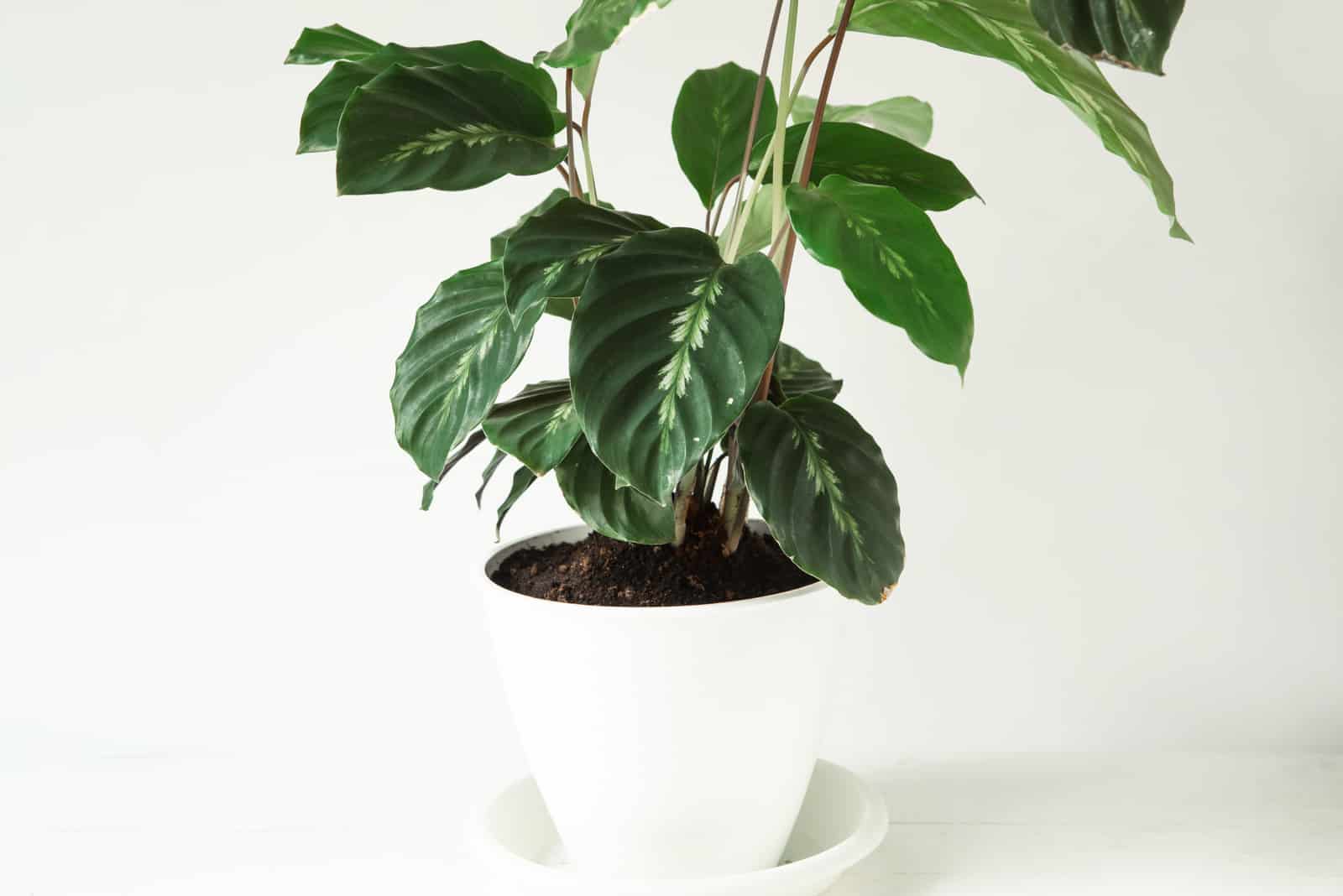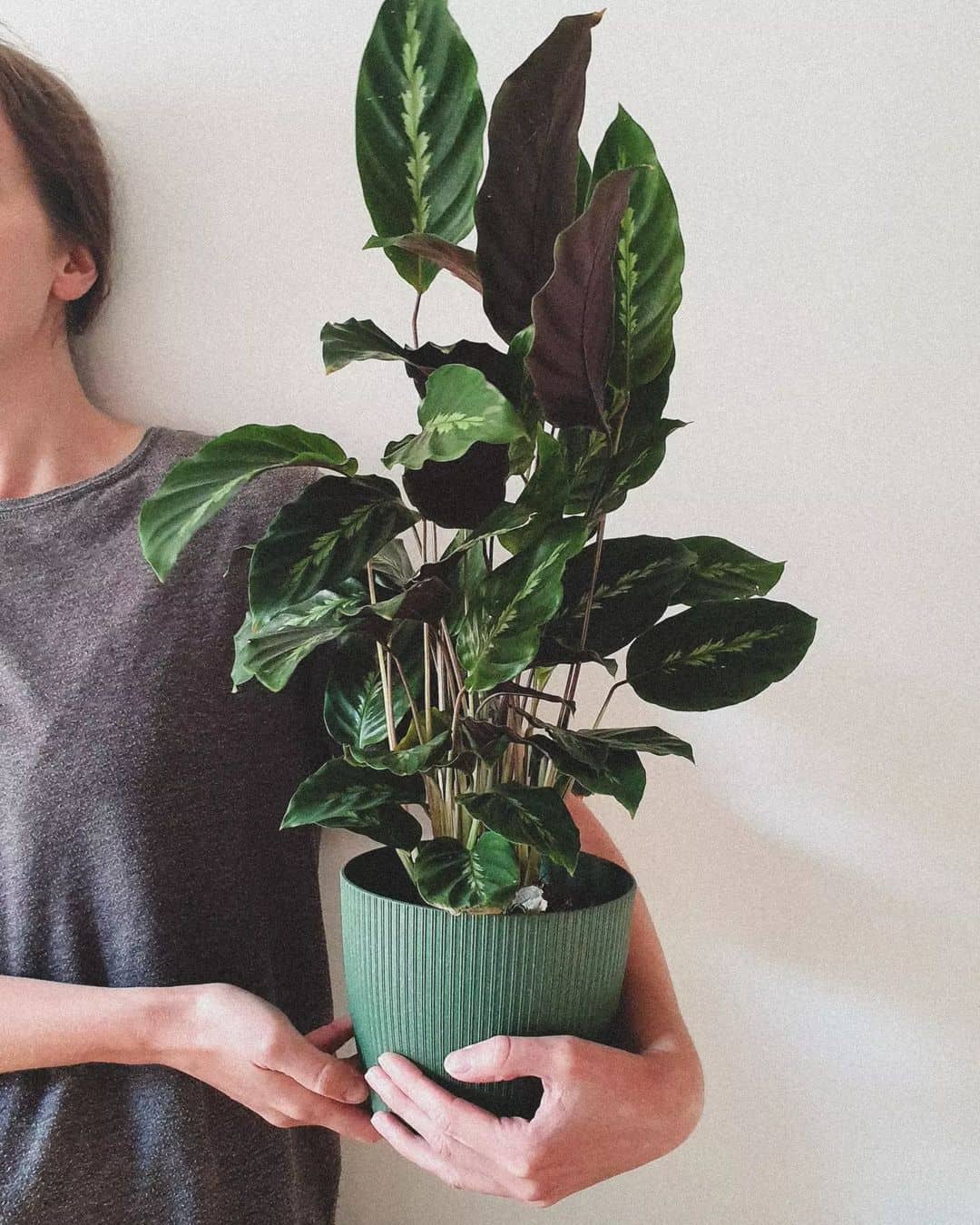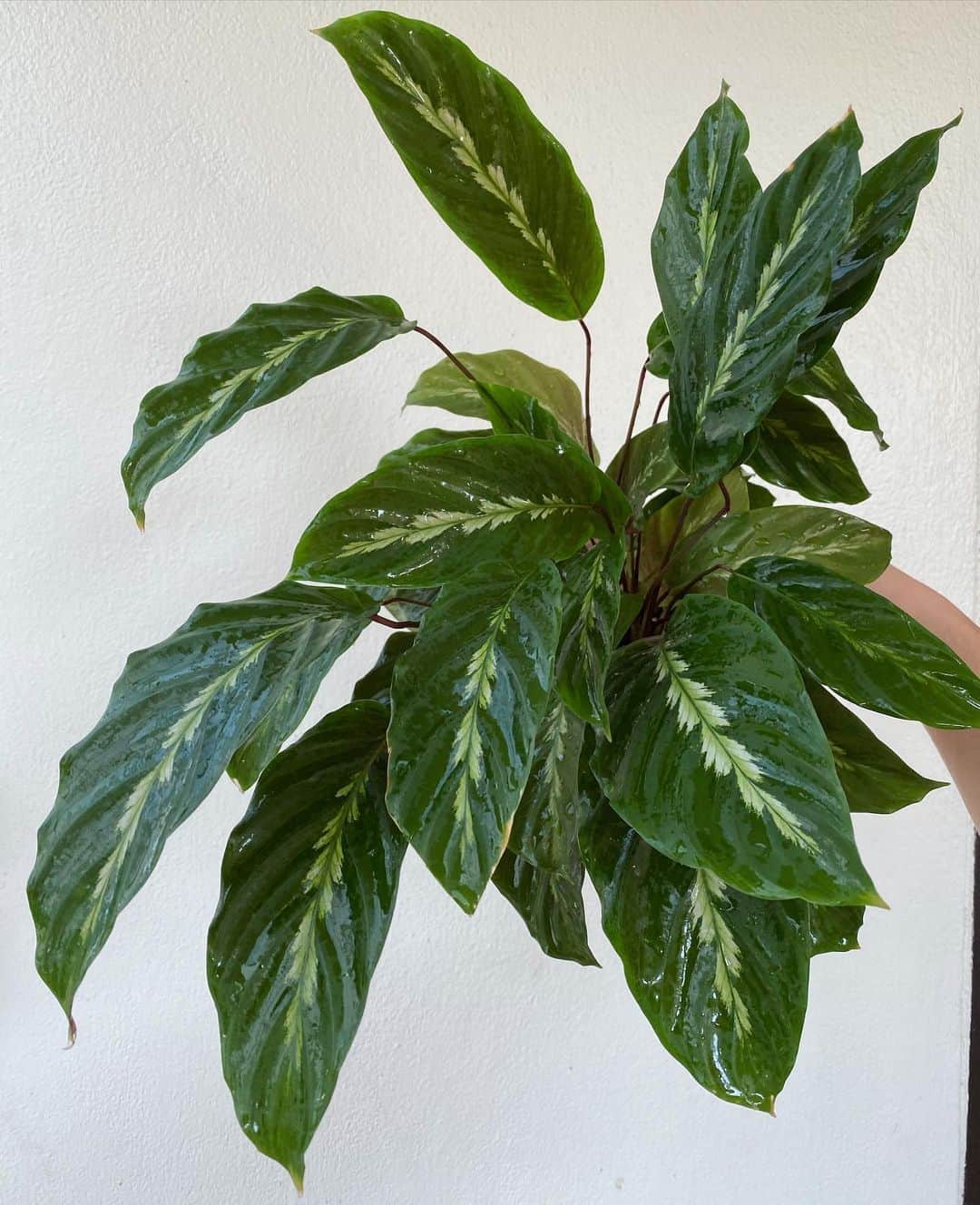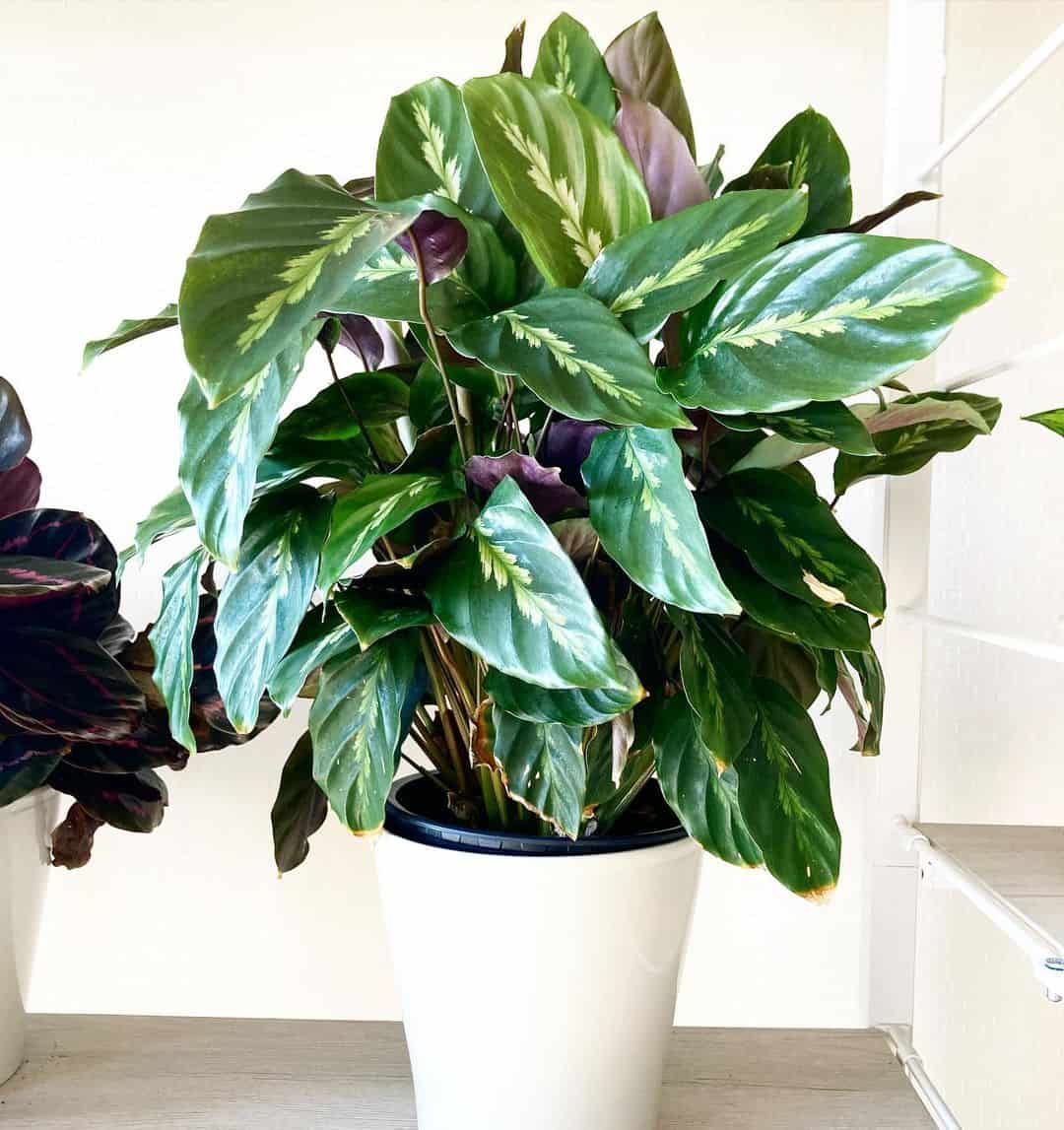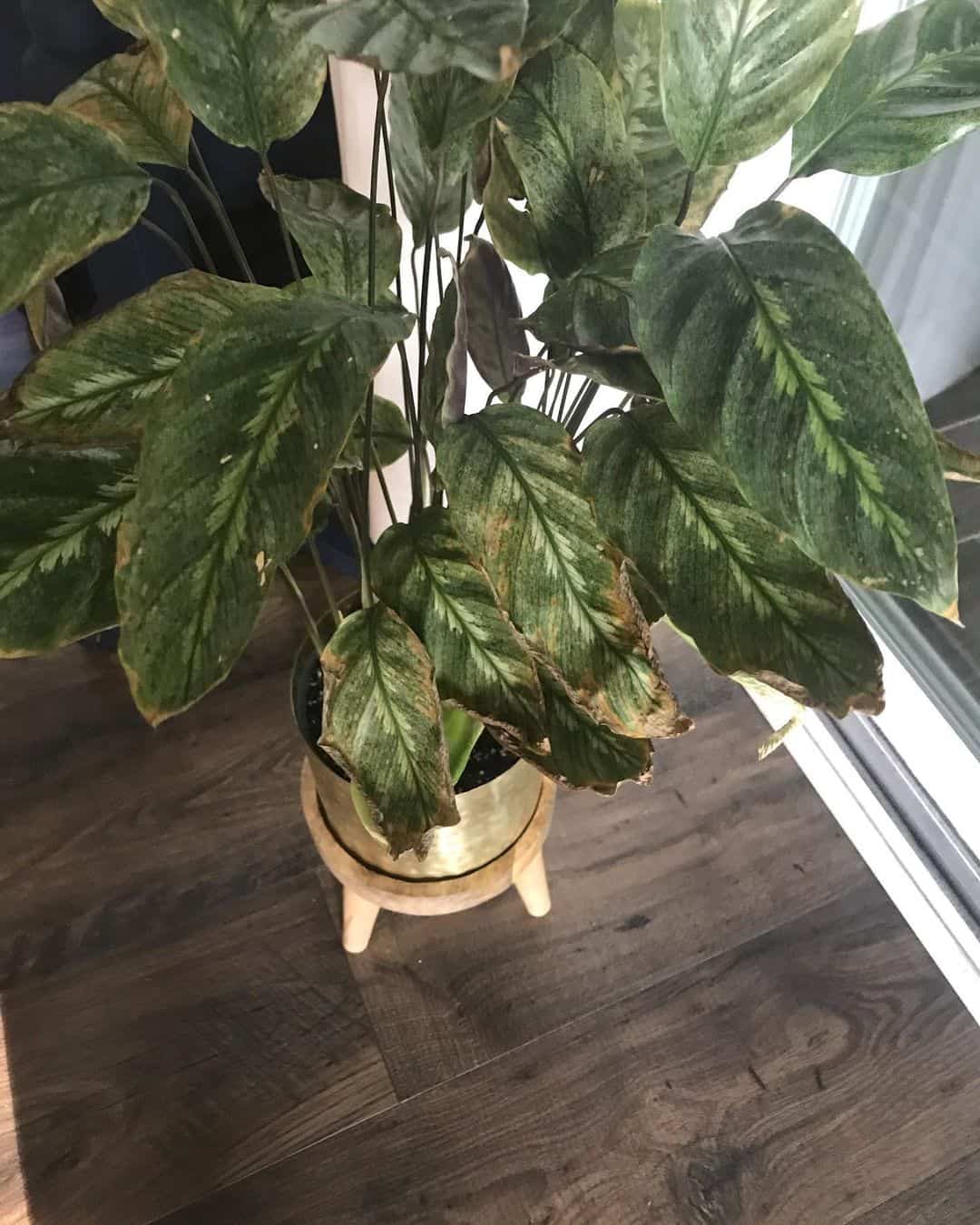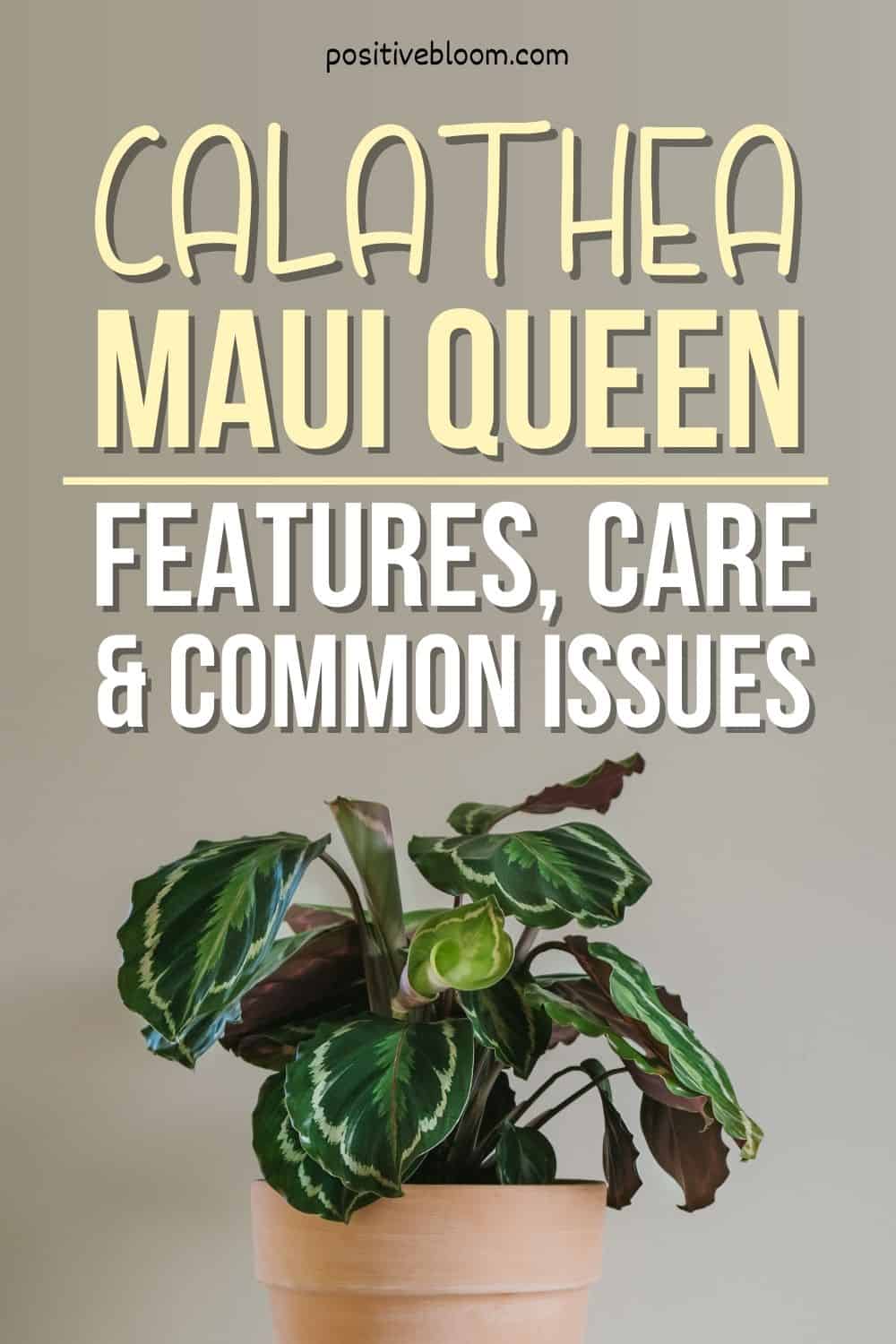When I started searching for so-called beginner plants, Calathea Maui Queen and Maranta popped up. I was utterly compelled by both, but I decided to get a Calathea first.
Don’t ask me why; it was just love at first sight.
The Calathea Maui Queen is a rare, hybrid cultivar of two Calathea species. It is a common houseplant, not only because of its stunning appearance but also because of its low-maintenance features.
I recommend that you get yourself one. Below you will find out how to care for the plant and the problems that may occur when growing one.
But first, some basic info:
[table id=176 /]Let’s start!
How To Care For a Calathea Maui Queen
As mentioned, a Calathea Maui is a perfect beginner plant and low-maintenance.
In my opinion, this Calathea plant is one of the best indoor plants to grow.
The plant will thrive when grown in places with high humidity and indirect sunlight,
Let’s see the care requirements and some care tips!
Light Requirements
This Calathea plant requires bright indirect light.
The native habitat of the plant may suggest the need for more sunlight. However, it’s essential to remember that tropical plants grow under the rainforest canopy, so they aren’t exposed to much direct sunlight, as trees provide them with partial shade.
To ensure good light conditions, place the plant near a window that faces north.
You can create partial shade by using a curtain during the summer. This way, you will avoid the direct sun and create appropriate light conditions. Place the plant in a brighter place during the winter.
If the plant doesn’t receive enough bright, indirect light, or if it is placed in low light, it can become stretchy or leggy.
The plant will also grow in full shade, although not as fast.
Another interesting fact about this Calathea hybrid is that it will grow in places with an artificial or grow light; it shouldn’t be exposed to a grow light for more than sixteen hours.
Of course, if you want to ensure good lighting conditions for your Calathea Maui, you can use a light meter.
This makes the plant perfect for places that don’t have much natural light, like offices or apartments.
Humidity Requirements
Prayer plants are native to rainforests, and the best scenario would be for you to mimic high humidity conditions in your home.
Improper moisture levels are the main cause of any complications.
Your kitchen and bathrooms have a higher moisture level; therefore, you can choose one of these rooms to place your Calathea plant in.
If there’s a need to increase the humidity level, you can purchase a humidifier.
A pebble tray is another way to increase moisture levels in the potting soil. If a humidifier is too expensive, you can make your own pebble tray. Fill a tray with water, add some pebbles, and place the pot on the tray with pebbles.
Make sure to keep the plant away from air conditioners and vents. These will dry out the air and reduce humidity, causing the watering needs to change.
Should I Mist My Calathea Every Day?
There is no need to mist the Calathea plant every day, and you can mist the plant once a week if you ensure humidity requirements.
Temperature Requirements
The plant is native to tropical rainforests, which means it requires warmer temperatures.
Keep the temperature between 70 to 80°F to avoid sunburns.
However, these houseplants may also tolerate lower temperatures, but I suggest you don’t let the temperature drop below 60°F. Otherwise, this may affect the appearance and the plant might look leggy.
Heat increases the need for moisture and that’s the reason why you should place the plant away from heating sources, such as fireplaces and radiators.
The Calathea Louisae is an indoor plant, and if you ensure it sits in the right place, it’ll be thriving in no time!
Potting Soil Requirements
As with every other plant, soil plays a crucial role in the plant care of your indoor plants.
There are three things potting soil needs to meet the requirements of this Prayer plant:
1. A good drainage system
2. A potting mix
3. Correct pH levels
The first thing you should ensure is a well-draining soil. A pot with drainage holes in is the best way to improve the drainage system. Another material that can be used to improve drainage is peat moss.
The potting mix for a Calathea Maui Queen should consist of 50% potting soil, 20% orchid bark, 20% charcoal, and 10% perlite.
This plant can grow in neutral and slightly acidic soil, with approximate pH levels between 6.0 to 7.5.
Watering
The watering schedule for this Calathea plant is once or twice a month during Summer and every two weeks during winter.
You should only water your plant using room temperature water to avoid temperature stress.
Let the soil dry between waterings, but don’t let it dry out completely.
Avoid watering wet soil because this will lead to overwatering.
Overwatering can cause root rot issues. See the “Common Issues” section for more information about root rot.
How Do I Water My Plant?
If you want to know how to water your plant properly, I’ll share some tips for watering with you.
Sometimes it’s hard to decide if the soil has enough water. You can easily check the moisture level if you put your finger in the soil.
During the growing season, the soil should dry out completely as you can accidentally overwater it.
During the colder seasons, the need for nutrients significantly reduces. The plant doesn’t need much energy and overwatering can cause more damage.
Never water the leaves, as they can suffer from different diseases caused by overwatering. I suggest you water over the top.
Stick to the usual watering schedule designed for the Goepperia Louisae Maui Queen, to ensure it gets all the nutrients it needs.
Here’s a video showing you the importance of proper watering of your Calathea plant:
Repotting
If you notice that the roots are coming out of the drainage holes, you should repot your plant. Due to the Calathea’s growth rate, you should repot it often.
The new pot should be a few inches bigger than the previous one. A larger pot equals more soil. If the Calathea’s roots have too much soil, they may suffer from root rot as the moisture level increases.
Each time you repot, make sure to water the plant the day before. Take your Calathea out of the pot and shake off its roots. Do it gently to avoid damage. Place the roots in the new potting soil (the soil needs to be fresh each time you repot). The air spaces should be closed, so you can gently press the soil down.
How To Fertilize a Calathea Maui
Another reason this plant is excellent to grow is because it doesn’t need much fertilizer.
The great news is that it doesn’t need to be fertilized at all during winter and fall (its dormant period), which saves you both time and money.
The plant needs to be fertilized during the growing season only (late spring to early summer).
If you want the fertilization to be successful, choose a fertilizer rich in nitrogen, phosphorus, calcium, magnesium, and potassium.
How To Prune The Prayer Plant
The plant’s leaves should be trimmed every year.
You should prune more often if you notice dead or old leaves. Pruning dead leaves will enable new leaves to grow healthily.
I need to remind you though, that each time you prune, you must sterilize the pruners.
By sterilizing, you will avoid further complications, such as infection, and reduce the plant’s susceptibility to pests.
How Do I Propagate My Calathea?
This Calathea hybrid is propagated by root division.
Let’s see how!
You will need a sterilized, sharp blade or knife, a new pot, and water.
The process of propagation should follow this pattern:
- Take the Prayer Plant out of the pot and shake off the soil to see the rootball.
- Separate the roots in the root ball.
- Secondary and tertiary roots should be cut using a sterilized, sharp blade or knife.
- Fill another pot with a potting mix that consists of peat moss, orchid bark, charcoal, and perlite.
- Take the plantlets and put them in another pot. Pay close attention to their distance, which should range from 2 to 3 inches apart.
- Water the soil, but be careful not to drench it.
- Place the pot somewhere with low, indirect light.
After completing this process, wait for between a month and a half and two months, so that the roots can develop.
More About Calathea Maui
I find it exciting that the Prayer Plant got its nickname because it opens and closes its leaves at night or day. That’s why the plant is considered to be a moving one.
Due to this feature, the plant shows off its incredible deep purple undersides of the leaves.
This is considered to be a functional adaptation.
According to Feng Shui, it promotes fame and reputation in your home.
It’s considered to be an air-purifier and contributes to your indoor environment.
Another great thing about this plant is related to its toxicity. The plant is pet-friendly, so you don’t have to worry if your cat or dog accidentally ingests any plant leaves.
Health Benefits
There are three health benefits of the plant.
Here’s the list:
- As an air-purifier, it ensures oxygen.
- It removes toxins from dust, providing fresh air.
- It is often used for dry skin issues and respiratory issues (it will increase humidity where it is placed).
Price
If you decide to purchase a Calathea Maui Queen, you will pay about $20-$30.
I have to remind you that the price above is the plant’s regular price.
You can sometimes find the plant on sale (like I did), and the sale price is usually about $10.
I think the Prayer Plant is worth all the money you spend on it.
Common Issues
Unfortunately, a couple of issues can occur with the Calathea Louisae plant.
These include changes in the leaves, diseases, and pests, and each problem can be caused by different reasons and have other consequences.
Let’s learn more!
Brown Leaves Or Tips
If you notice brown tips on the leaves, you should stop using tap water that contains minerals, fluoride, or salt.
Solution: Remove the brown leaves and start using filtered water.
Yellow, Curly, Or Drooping Leaves
The leaves of a Calathea louisae will turn yellow if the plant lacks humidity.
Solution: Use a humidifier.
The leaves can curl or droop when they don’t receive enough water because of excess heat, or when the plant suffers from root rot or any other disease.
The leaves will reduce their surface area and thus, water loss, by curling.
The leaves will curl inward or upward due to underwatering. The plant might look limp, or your Calathea may have drooping leaves.
Solution: Give your plant a good soak. Water it more often until you see an improvement, and stick to the watering schedule.
Bear in mind that the watering schedule changes as the conditions change.
Root Rot
As mentioned above, overwatering can cause root rot. You’ll need to remove this.
The first thing you should do is take your Calathea out of the pot. Inspect the root system and search for any discolored roots. They will smell unpleasant, and the soil will have a mushy appearance.
Whenever the soil is too wet, it will attract fungus, the most common pathogen. Pathogens decompose the root tissue and eventually destroy the entire root system.
The more excess water, the greater the chance of disease. To prevent this, I suggest you use the appropriate pot size and make sure that the pot has drainage holes.
Solution: You can remove root rot by taking the plant out of the pot and using sterilized scissors or pruners to cut off the affected roots. Then, you should repot the plant and water it thoroughly.
Pests
Spider mites and mealybugs are the most common pests that can affect the Maui Queen plant.
You will know that your plant has Spider mites if you notice tiny spots on the undersides of the leaves, they can be either white or brown.
Solution: The first thing you can use is a mixture of alcohol and water. Fill a spray bottle with the mixture and spray over the affected leaves. Dish soap is another great solution. Mix it with water and fill the spray bottle with it, then spray over the affected leaves. Alternatively, you can use neem oil.
Mealybugs cause cotton-like changes on the leaves. Mealybugs are tiny and white and can be easily spotted.
FAQs
What is the size of a mature Calathea Maui Queen?
You can expect a Calathea Maui Queen to grow up to 3 feet if grown indoors. Its stunning, glossy green leaves with purple undersides can grow up to 3 feet.
What is the difference between a Calathea and other plants?
The Calathea genus has about 60 different species. The most significant difference between these species and others, in general, is the leaves. Calathea plants have distinctive, dark green leaves with scalloped edges and silverish brush marks on the top.
What are the most common types of Calathea?
The most common types of Calathea plants are Calathea Rosey (Calathea roseopicta ‘Rosey’), Snakerattle plant (Calathea lancifolia), Furry Feather (Calathea rufibarba), Corona (Calathea roseopicta), and Dottie (Calathea roseopicta ‘Dottie’).
Wrapping Up
There are many reasons why the Calathea Maui Queen is one of the most popular houseplants; it’s rare, low-maintenance, beneficial, and relatively cheap.
Take good care of your Prayer Plant, as it’s worth it when you see your plant thrive.
Until next time!
Like this post? Share or pin it for later!

